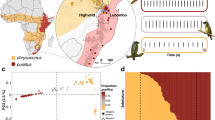Abstract
Arising from: N. Veselka et al. Nature 463, 939–942 (2010)10.1038/nature08737; Veselka et al. reply
Echolocation of bats is a fascinating topic with an ongoing controversy regarding the signal processing that bats perform on the echo. Veselka et al.1 found that bats that use the larynx for producing the echolocating ultrasound have a stylohyal bone that connects the larynx to the auditory bulla. I propose that the stylohyal bone is used for heterodyne detection of Doppler-shifted echoes. This would allow very precise frequency resolution and phase-sensitive analysis of the returning echoes for determining the velocity of echolocated objects like insects.
Similar content being viewed by others
Main
The stylohyal bone connects the larynx, the area where the ultrasound is generated, to the auditory bulla that is in turn connected to the cochlea. Veselka et al.1 found by micro-computed tomography that this connection is present in all of the 26 species of laryngeally echolocating bats that they analysed. The function of this bone is not yet entirely clear. Veselka et al.1 list three possible functions: the stylohyal bone could transmit the outgoing signal in order to ensure its accurate registration by the brain, the bone could provide a mechanical reafference, or it could dampen vibrations of the middle ear in order to prevent self-deafening.
I would like to suggest another purpose. The stylohyal bone could transmit the outgoing signal to both ears in order to provide what is called a ‘local oscillator’ in electronic signal processing. In heterodyne detection schemes the reference signal from the local oscillator is mixed with the signal to be detected. The result is a beat note at the difference frequency of both signals. The beat note arises from alternating constructive and destructive interference between the signal and the local oscillator. This technique is widely used, for example in commercial frequency-modulated (FM) radio receivers. It allows for very precise and phase-sensitive frequency measurements. Such precise and separate measurements of the Doppler-shifted return signals at both ears of the bat could yield two components of the velocity vector of the object that scatters the bat’s ultrasound signal, for example an insect. This would enable the bat to predict the location of moving objects with much higher accuracy. If the stylohyal bones or the auditory bulla resonate at the frequency of the outgoing signal with very little damping, they could preserve the outgoing signal to bridge the time lag between the end of the outgoing signal and the beginning of the return signal.
References
Veselka, N. et al. A bony connection signals laryngeal echolocation in bats. Nature 463, 939–942 (2010)
Author information
Authors and Affiliations
Ethics declarations
Competing interests
Competing interest: declared none.
Rights and permissions
About this article
Cite this article
Wittrock, U. Laryngeally echolocating bats. Nature 466, E6 (2010). https://doi.org/10.1038/nature09156
Received:
Accepted:
Issue Date:
DOI: https://doi.org/10.1038/nature09156
This article is cited by
-
Veselka et al. reply
Nature (2010)
Comments
By submitting a comment you agree to abide by our Terms and Community Guidelines. If you find something abusive or that does not comply with our terms or guidelines please flag it as inappropriate.



